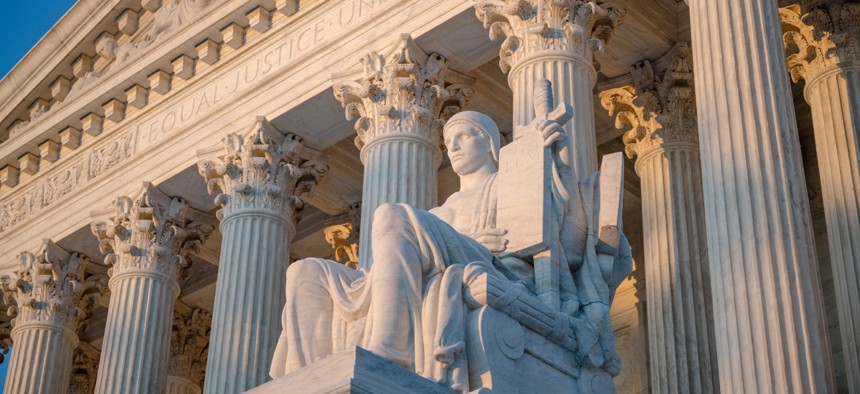How the Supreme Court’s West Virginia v. EPA Decision Will Upset the Administrative World
The ruling will likely sow confusion and gridlock, and shift the balance of power in an unintended way.
When the Supreme Court issued its divisive environmental policy decision, West Virginia v. EPA, at the end of its last session, conservatives applauded that the Environmental Protection Agency “can no longer sidestep Congress to exercise broad regulatory power,” as West Virginia Attorney General Patrick Morrissey put it. The decision shut down what the Heritage Foundation’s Derrick Morgan called a “power grab” by EPA.
For the Biden administration, it was “another devastating decision that aims to take our country backwards,” the president charged. The outgunned liberal minority on the court said that the ruling had stripped EPA’s power “to respond to ‘the most pressing environmental challenge of our time.’ ”
The battle over the deep state—and, especially, administrators’ power to interpret the law in ways that fit the president’s own policies—has never been so intense. Does the case really mean that the Supreme Court has kneecapped the power of federal bureaucrats?
The case is important because it points directly to the key issues of trying to run a government in an age of such polarization. The court’s apparently clear dictum—that, in important policies, federal administrators only have the power that Congress explicitly gave them—is actually anything but. And its efforts to rebalance the separation of powers is likely to bring much greater confusion than clarity.
For federal program managers, the question of how best to follow the law has always been a delicate dance. When the Johnson administration launched its War on Poverty nearly 60 years ago, reformers not only worried about providing money to the nation’s struggling cities. Johnson wanted to transform political power and pledged “to strike away the barriers to full participation in our society.” The goal was not only to help the poor but also to empower the poor.
To make that work, the law required programs to provide “maximum feasible participation of residents of the areas and members of the groups served.” The phrase “maximum feasible participation” invited a carnival of conflict. Just what did “participation” mean? That administrators needed to listen to citizens—or follow what they wanted? Just what is “feasible”—and who gets to decide? And don’t even get me started with “maximum.”
Congress, in fact, fell so much in love with the word “feasible” that it used it three other times in the antipoverty act to describe times when federal administrators were responsible for doing things, to the “extent feasible.” Take the brand new idea of showering local governments with cash, transforming their political decision making and adding federal requirements, and the circumstances were ripe for conflict.
In fact, the always sage and invariably contentious Daniel Patrick Moynihan could not resist spinning off the phrase for his 1969 book, Maximum Feasible Misunderstanding, which held that the program was the product of activist social scientists and the New York elite. One of Robert F. Kennedy’s former legislative assistants countered that Moynihan’s argument was a “long exercise of condescension” and that his appointment to the Nixon administration was “evidence that in some high places, snake oil still passes for medicine.”
The charged rhetoric in West Virginia v. EPA thus is part of a long-running battle over who gets to call the shots on government policy. It’s also a snapshot of the position that government managers find themselves in as they try to administer the law, and that cuts in three ways.
First, the more contentious an issue and the more polarized the politics, the more vague legislation is likely to be. Getting anything passed in Congress means finding language around which the sponsors can cobble together a majority. The easiest way to do that is to agree on something fuzzy. Indeed, ambiguity is often the only road to getting anything done.
In Chevron v. Natural Resources Defense Council (1984), the Supreme Court held that it was acceptable to find “reasonable” interpretations when statutes are “ambiguous.” Giving administrators that much discretion was a bad idea, the court decided in West Virginia, and it pushed back on Congress to be clearer and administrators to be less far reaching.
That might be a neat bit of judicial argument, but it’s politically impossible. In fact, if the court holds to that principle, the result is likely to be even more gridlock, because the court will be asking for Congress to do what it can’t do now, if it ever could in the past.
Second, no matter how hard Congress tries, ambiguity is the inevitable product of lawmaking. When laws run thousands of pages, and when they’re often glued together in late-night conclaves near the end of sessions, inconsistencies are inevitable. There often are more and less smart ways to do things, and if laws on the other hand are overly prescriptive, administrators can find their hands tied when it comes to saving taxpayer dollars.
Indeed, it’s often smart to leave wiggle room in new laws, because many legislative issues are so complicated that only the teams of experts in federal agencies are likely to figure out how to actually do what Congress wants done.
Third, in West Virginia, the Court held that the issues in the case constituted “a major questions case,” which created a tighter limit on EPA’s discretion. This “major questions doctrine” had been debated for some time. West Virginia, however, was the first time a majority of the court had embraced the principle and declared it a doctrine (though it’s hard to see how something could be promulgated as a stated principle when the principle had not previously been stated by a majority).
Now, it certainly makes sense that “major” issues ought to be decided by Congress. But just where is the boundary? How major an issue is “major?” The label has shades of “maximum feasible participation” and invites an avalanche of judicial challenges.
The Supreme Court set out to shift the balance of power, away from the executive and back to Congress. In fact, it’s asked Congress to do what it can’t (or won’t) do. It’s told administrators that they can’t do what they often must do. And that ends up inevitably parking these issues at the court’s doorstep.
In the end, the court probably has shifted the balance of power, but not how it intended. By creating a series of conundrums, it has ensured that many more of these issues about administrative power will end up on its own docket. That would shift the power not only away from executives but also away from Congress. It puts it, instead, into the hands of a small coterie of black-robed figures who have neither the expertise nor the instincts for sorting through the big issues of the administrative state.








